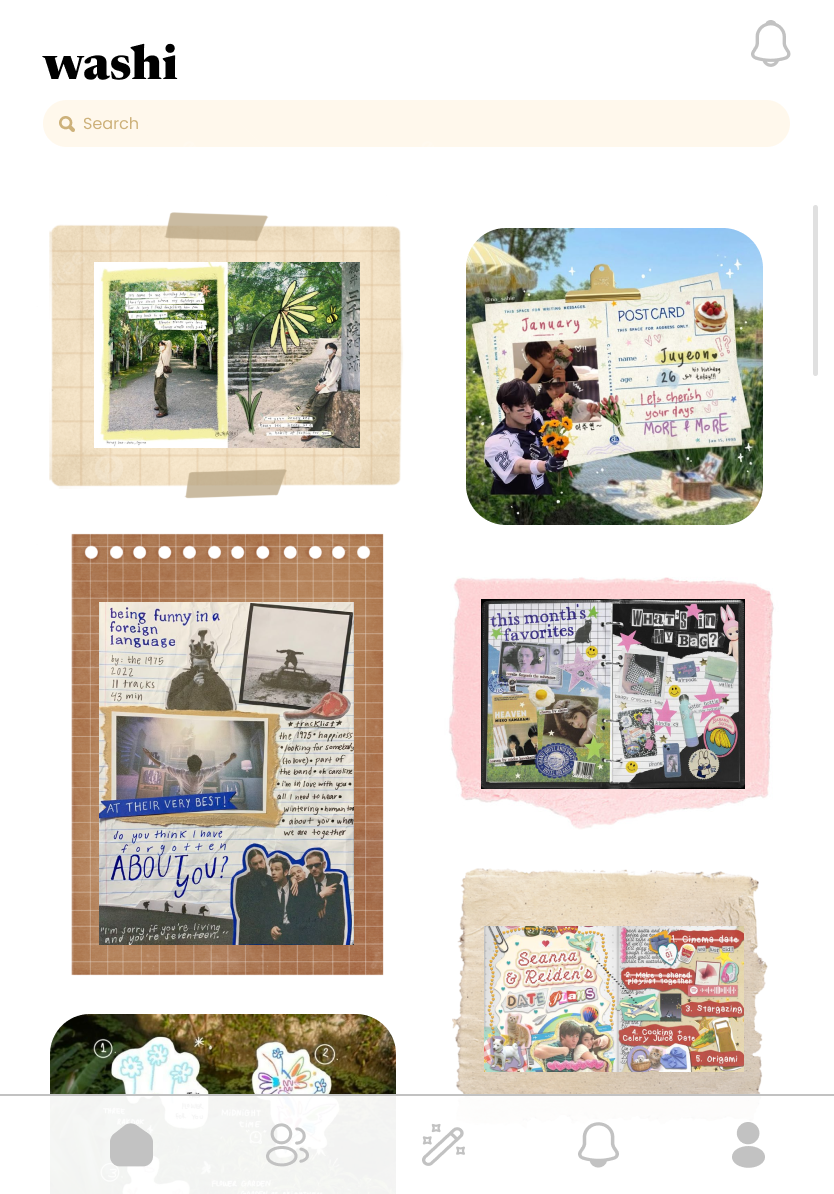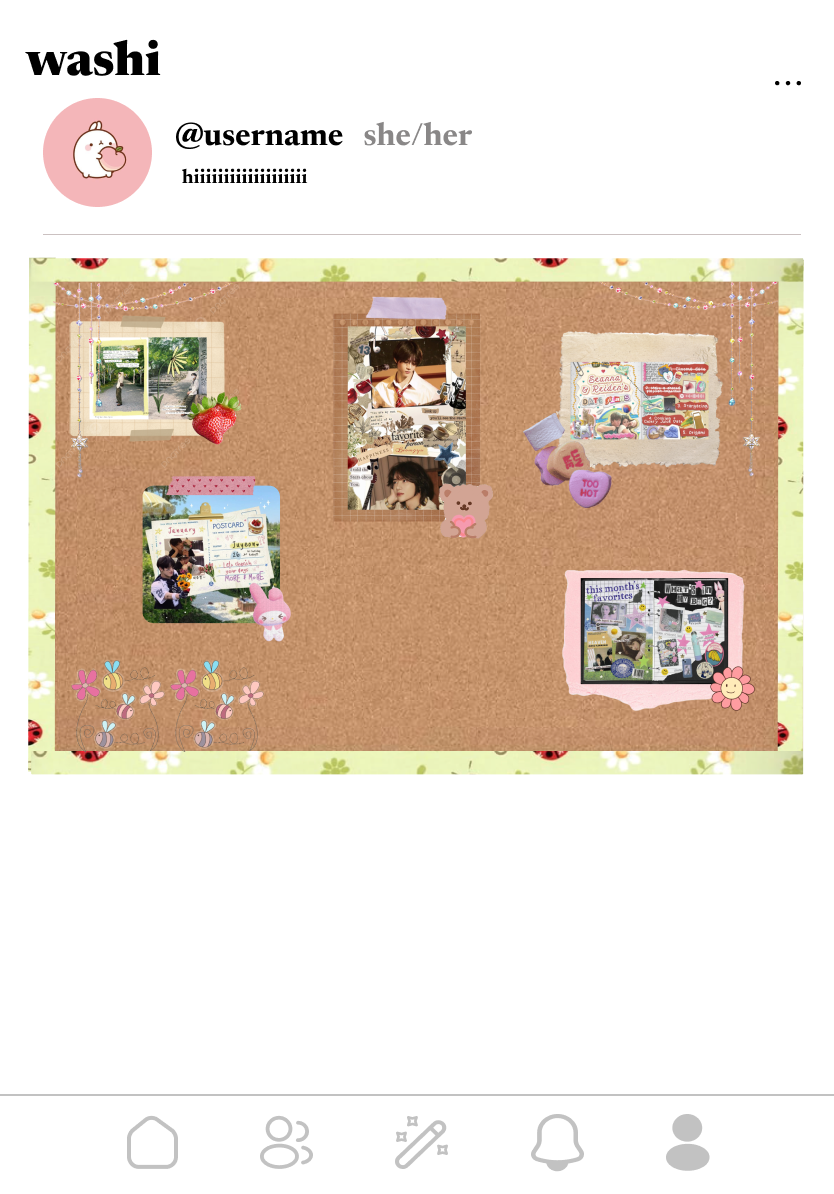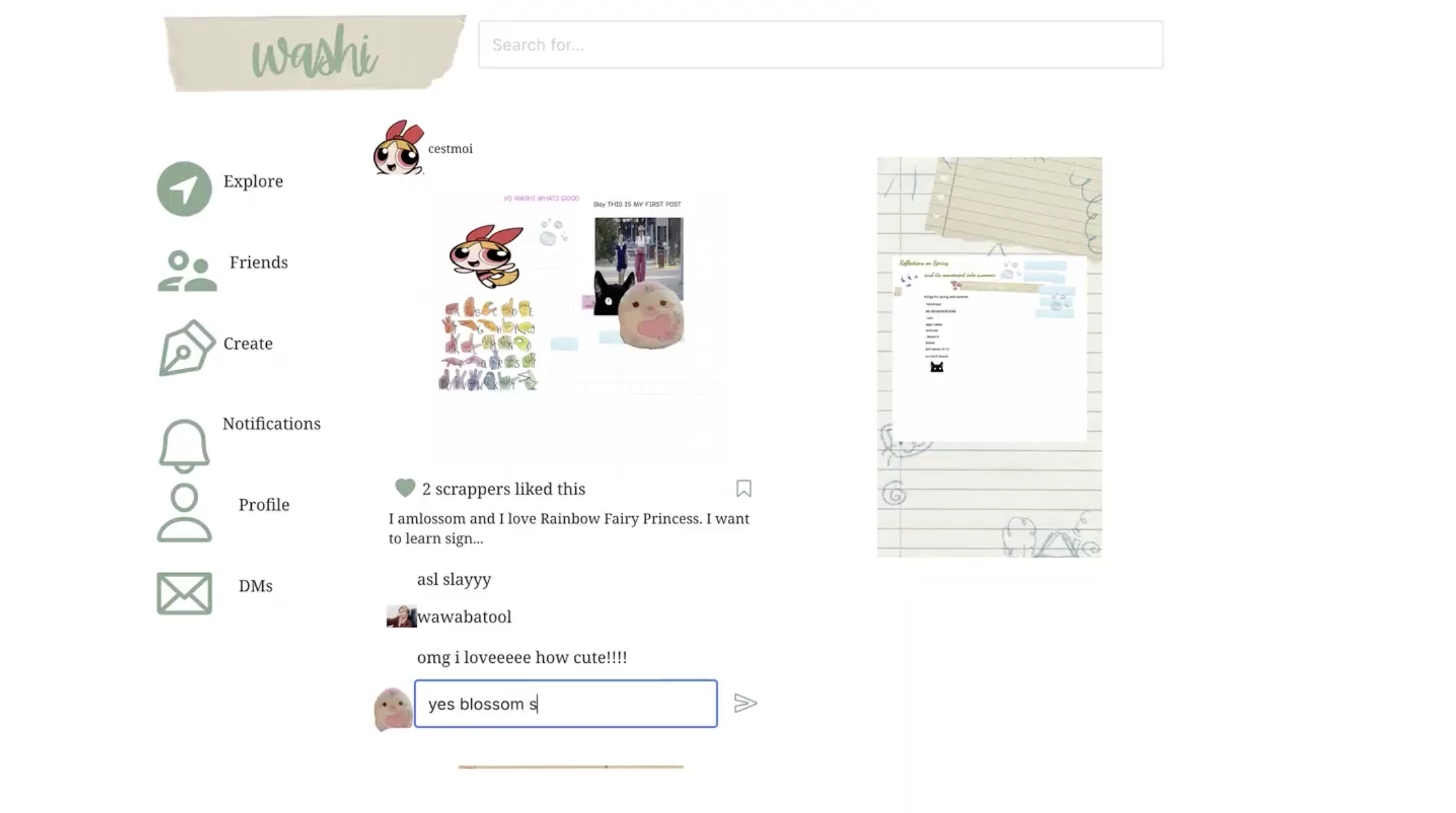Everybody’s Creative
Mar 2025 - June 2025
CS 278: Social Computing
During CS 278, my team and I worked on a 10 week-long project to create and launch a creative social media platform. Our social media platform, which launched to 40+ users, is Washi.
Washi is a social web app that lets users create, customize, and share digital collages. Designed using both Bubble and React, Washi combines the flexibility of no-code development with custom mobile functionality to deliver a smooth, creative experience across web and mobile platforms.
Washi was able to achieve a 40+ user base during its 8 hour launch period with 34 posts on the platform—with many users saying that they loved the concept and would like to continue using it in the future!
Tools: Figma, Bubble.io, React, FramerMotion, Tailwind, Vite, Node, Git
Roles: Project Manager, UX Researcher, UI/UX Designer, Lead Developer
Team: Maroua Bezzaoui, Kathleen Clarke, Mai Mostafa
Our Design Process
CS 278 is a course that encourages you to tackle the very complex problem of social media. In 10 weeks you are expected to create, iterate upon, and launch a social media platform.
We knew going into this course that we wanted to create a social media that was engaging, unique, and creative. Many of our own critiques of the most famous social platforms centered on the fact that they felt much more performative than it felt expressive—the original purpose of social media. We took that inspiration created the first sketches and mockups of Washi, a social media centered on creativity.
Our First Iterations
Initial Sketches and Exploratory Mockups
Final mockups after brainstorming
After conceptualizing the platform, we had one primary point of contention: what should it be on? I was convinced it should be a mobile application—most social media is. However one of my team members was very passionate about it being on Laptop or iPad at the very least in order for it to give users more creative freedom. This was the main question we sought to answer with our experience prototype. For this, we had pairs of users make collages together on Laptops, iPads, and Phones to see which most allowed users for creative expression.
Experience Prototyping
Phone Experience Prototype
Design Changes and Iteration
We came to the conclusion from our experience prototypes that in order for the platform to be fun it should also look fun. It should look like an environment where one can create without feeling like they have to think so hard about it. That led to the change in our logo and overall design language.
We found that the changes in font, color scheme, and usage of space allowed users to feel more comfortable creating in the environment. The necessity to click on a post to see more information about it without necessarily leaving the page allowed users to easily interact with one another’s content, creating much more engagement across the platform as well. The emphasis on the “Friends” tab immediately after “Explore” also emphasized interaction with close-ties, making the whole platform feel much more personal. This was also aided by the description of the users as “scrappers”, creating a distinct community identity around being a creative on this platform.
This design is certainly not perfect, due to the time constraints of the course, we had to dedicate more time to implementation and launch of the platform. But it did accomplish our original goal—to create a fun, personal, and creative social media that is free from the performative nature of many modern platforms.
Laptop Experience Prototype
Through this, we found that users felt they had much more creative freedom with the Laptop prototype, as it allowed them to crop, copy, and find external images easily. This allowed for a much more creative final collage compared to our other prototypes, and ultimately allowed users to accomplish the goal of our application—creative self expression.
Because of this, we had to pivot. Not only in terms of platform, but in terms of design language. We noticed through this that many of our initial mockups simply did not align with the kind of user interaction we were striving for. Our users were creating fun, silly, and expressive content, but our mockups showed a much more serious, aesthetics-based platform. Our design language had to change in order to match the environment the users were naturally creating.
iPad Experience Prototype
Implementation
This project was implemented in two parts:
Bubble was used for a majority of our functionality and UI. Thanks to its front and backend workflows and vast library of design elements, we were able to primarily develop this application with it, allowing us to focus the majority of our time and resources on our custom component, the collage editor.
The Collage Editor was made with React and is available via this GitHub Site and Repository. This was coded in JavaScript and was the primary usage of my time during implementation. I also used some public libraries such as Tailwind for UI and Framer Motion for dragging and dropping, as well as Vite for deploying. The collage editor as it is made in the code facilitates drawing, tapes, stickers, image upload, text, and capture.
I was responsible for the creation of the college editor as well as much of the Bubble functionality, if you would like to ask me more about how I created these things, feel free to reach out to me via the contact form!
Our Final Project Demo
Reflection
Washi launched to 42 users who made 34 posts over the course of 8 hours. This was double the CS 278 requirement for our launch, and nothing could make me happier.
I think what I loved the most about Washi was how it pushed me. It is through making this that I taught myself Javascript. It is through making this that I experienced launching a platform for the first time despite something like that feeling incredibly out of my reach. It is through this that I got to see the impact of my work for the first time, and people loved it. They thought it was incredibly fun, and nothing could make me happier.
If I were to continue my work with Washi, I would want to push it to its very highest potential. I would want to iterate on the design, to include features we had to forego for the sake of launch, such as the personal bulletin board which you can decorate on your profile or the ability to click-in and explore other people’s collages more closely. I would happily work on Washi again in the future, and I am grateful for everything it taught me.










